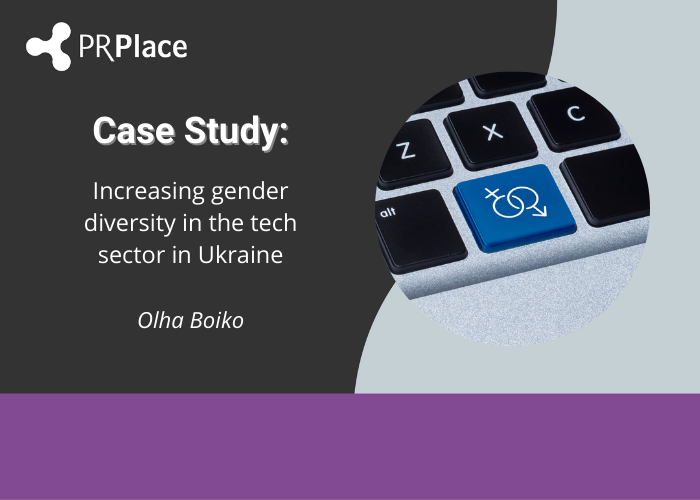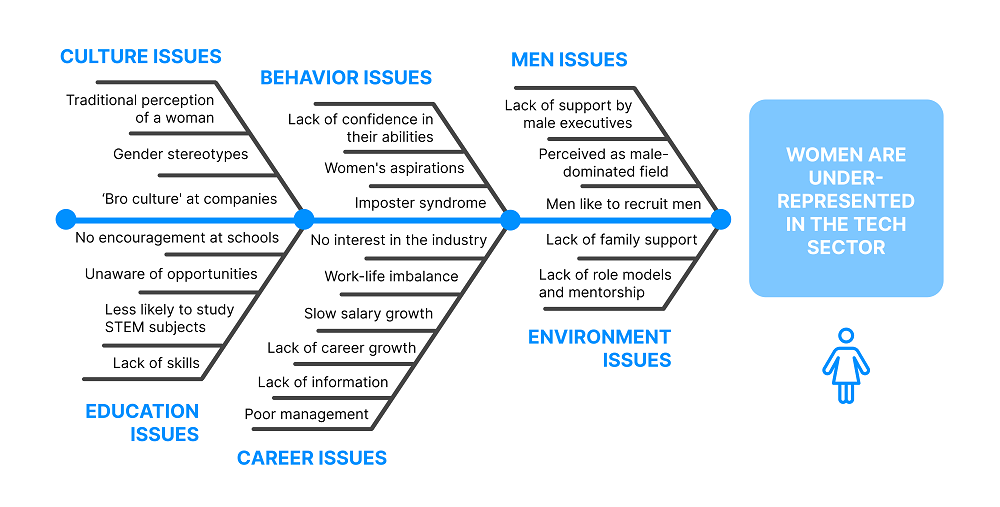International PR case study: Increasing gender diversity in the tech sector in Ukraine

About the author
Martin Flegg Chart.PR FCIPR is a PR professional specialising in internal communication. He is also a guest tutor and assessor for PR Academy on CIPR qualification courses.

This case study is based on a CIPR Professional PR Diploma assignment by Olha Boiko, edited by Martin Flegg.

In recent years, Ukraine has significantly enhanced its position in the global IT market. Its talent pool is approaching 200,000 software developers and the sector demonstrates steady annual growth.
Most IT professionals have an extensive track record, and a wide range of career opportunities, with many companies competing for their skills.
Innovecs, a global digital transformation tech company with R&D facilities located in Ukraine, has launched initiatives to succeed in attracting new talent. One of them – InnoCamp, an educational programme for IT experts, aims at improving technical skills, developing qualifications and new talent. Another initiative is InnoHub – an online and offline venue for businesses in IT to exchange experience. It aims to inspire the tech community to interact and grow.
Ukrainians are open-minded to international trends, including promoting gender equality and women’s rights. Not only is this socially important, it also stimulates business activity and growth. Studies have shown that gender diversified teams lead to more innovation and improved performance.
Despite its steady and versatile growth, the tech sector is one of the most male-dominated in Ukraine, with women representing only 24% of the industry’s workforce. The global tech industry shows the same imbalanced situation with women accounting for 28-42% of all employees at leading companies. Attracting more women to the tech sector could help Ukraine overcome the problem of the growing demand for IT professionals and provide the human resources necessary to continue the industry’s growth.
In late 2020, only 26% of the Innovecs workforce were women, with some progress being made to improve the gender balance. 47% of top management were female, and 57% of the total number of promotions in the company were achieved by women. In order to continue this progress, resolve the tech skills shortage in the company and maximise the benefits of gender-diverse teams, Innovecs has decided to focus on attracting more women by taking steps to influence the situation both internally and externally.
Strategic public relations and communications can play a key role in influencing positive changes to gender balance in the Ukrainian tech sector, and in educating women about the opportunities and advantages they could have with a career in tech. This international PR case study details how they approached it.
Research and situational analysis
To succeed in attracting more women to Innovecs, and increase overall gender diversity in the tech sector in Ukraine, the Innovecs PR & Communications team needed to research the current situation with regards to gender diversity and expose the reasons for the current male dominated status quo in the industry.
This would enable Innovecs to fundamentally address the gender imbalance issue by developing and implementing an insight driven public relations and communications strategy.
The situational analysis had the following objectives:
- Determine the external and internal factors that impact on the gender gap.
- Summarise opportunities and advantages for the communication strategy.
- Consider threats and weaknesses that may influence the communication strategy.
- Study and reveal the reasons that maintain the status quo.
- Map and understand the existing stakeholders. Who are they? Are there any supportive stakeholders among them that can be transformed into influencers? Can they affect the current situation and engage other audiences?
The research used inductive reasoning and analysed internal and external secondary data to clarify the reasons for the current under-representation of women in the tech sector in Ukraine based on insights from local and international surveys and research. It also aimed to describe the factors that impact the situation and examine Innovecs’ environment and efforts, connected to the gender diversity issue, and its stakeholders.
Analysing the external and internal environments to inform the communications strategy
A PEST (external) and SWOT (internal) analysis was conducted to reveal the influencers and opportunities to inform the development of the communications strategy.
The political dimension of the PEST analysis revealed a reducing pool of IT professionals, both men and women, due to people leaving the region because of military conflict and a lack of government support for women in tech. The support of EU programs, such as the EU4Digital initiative, indicated that local authorities, as a new stakeholder group, should be reached through further communication.
Economic factors make the tech sector attractive for female employees with its steady growth, lower taxes and higher wages. Highlighting these benefits should be considered when communicating with a wider audience.
Social factors demonstrated the potential for an increased number of women in tech, as the percentage of women working in the industry is growing, and they are driven not just by economic factors, but also by a willingness to join open-minded teams. Educational aspects make communication on tech educational programs and events essentially important.
Technological factors demonstrated the high usage of the internet in Ukraine with the country ranked second in the world in the number of women using social networks – 57% (11 million users), making social networks a relevant tool to reach target audiences.
The SWOT analysis assessed factors that were either supportive or inauspicious for increasing gender diversity. The major weakness was the media coverage of women in tech initiatives supported by Innovecs. The company only highlighted them in its press releases, leaving aside the audience on social media, which was an obvious opportunity. The analysis also showed several opportunities for engagement with audiences, for example, through promoting Innovecs’ female leaders in media and nominating them for national awards in the tech sector, thus positioning them as role models.
Root cause analysis to explore the status quo and key drivers for increasing gender diversity with communication
Reports and articles summarising the key reasons for the under-representation of women in the tech sector and the factors that influence their professional development, were sourced and reviewed
A Fishbone diagram was used in this part of the research as a cause-and-effect discovery tool to examine the under-representation of women in the tech sector in Ukraine based on local and global data in the reports and articles. Ukraine lacks deep research in this area, therefore, international research findings which correlated with Ukrainian data were used to gain insights. Further national research is needed to present a clear picture of the causes of under-representation of women in the Ukrainian tech sector.

Encouraging young women to choose a tech career, faces obstacles at the early stages of their education. A global UNESCO report showed that girls lose interest in STEM subjects in their adolescence, which leads to fewer girls of this age taking advanced maths and scienceiv. A PwC UK research reported that the gender gap in technology starts at school – only 27% of female students said they would opt for a career in technology, compared to 61% of males. This suggested that the Innovecs communication strategy would need to engage with the educational sector.
PwC research also revealed that females weren’t considering technology careers as there was insufficient information about what working in the sector involved, and also, because no one was ‘putting it forward as an option to them’. A UNICEF poll in Ukraine confirms this with 31% of female respondents answering that they are insufficiently informed in the IT careers area. It also showed that 28% of female respondents note they are not interested in the industry, 23% are not confident in their abilities, and 17% consider tech professions to be malevii. Communication can play a key role in delivering information to this audience group.
Women also take up fewer jobs in technology because of gender stereotyping and cultural expectations that discriminate against them, i.e. traditional female roles as wives and mothers. Wtech, a community for women in tech originating in Ukraine, conducted a survey among the community that revealed 41% of respondents reported that the perception of a woman as a care-giver influenced their career. More than 80% lacked family support as they developed their careers. 70% of surveyed women experienced ‘imposter syndrome’, often due to a lack of self-confidence stemming from the absence of family support. This is supported by the findings of international research. According to a report by TrustRadius, 3 out of 4 female tech professionals have experienced imposter syndrome at work.
For those who do opt for a career in IT, the lack of successful Ukrainian women in the industry can also be an obstacle. Over 50% of those surveyed by Wtech noted that they lacked inspiring role modelsx. A report by TrustRadius also showed that it’s more difficult for women to find role models in the industry than it is for men – 44% of women found it fairly or very difficult to find mentors/role models.
McKinsey’s survey found that corporate culture and a lack of support by male executives are critical issues for women. The TrustRadius report indicated that the majority of women in tech have experienced ‘bro culture’, making them feel uncomfortable, excluded, or unsafexiii. Any communications developed to increase gender diversity should be targeted towards this ‘culture’s’ male representatives.
The tech industry is known for its work-life imbalance. Long hours and overtime are often the norm here. ‘Yet women feel more pressure to put in extra work than male colleagues’, states Women in Tech Report published by TrustRadius. Attracting more women into tech roles faces obstacles, as does retaining female tech talent. A report by Indeed found that the most common reasons for women leaving tech jobs are a lack of career growth, poor management, and slow salary growth – 28%, 24.6%, and 24.4% respectively.
With Innovecs’ growing number of female top managers and promoted employees, it’s essential to showcase their inspiring stories in communication.
Stakeholder mapping to identify key targets for strategic communications
Stakeholders were mapped into four categories for the communication strategy.
Advocate: Innovecs’ female staff with prominent careers and expertise who can act as role models. InnoHub external female speakers invited influencers and informed members of the public who can also be supportive of communication. Local women in tech communities that lack the company’s support and attention. Female students of tech universities and courses.
Dormant: Innovecs, and other Ukrainian tech company employees, both male and female, who can recognise the importance of highlighting the advantages of tech careers for women. A tailored communication strategy could turn these groups into influencers.
Adversarial: General public and local opinion leaders supporting retrograde roles of women as care-givers, wives and mothers. It is essential to consider the risks of their impact on communication activities designed to attract more women in tech.
Apathetic: Local passive authorities and persons of various ages with no opinion regarding careers for women and opportunities in the tech sector. This audience are potentially an opportunity for communications and to foster fundamental changes in the mindsets of people.
Strategic PR recommendations and objectives
To develop an effective communication strategy to attract more women to Innovecs, and increase gender diversity in the tech sector in Ukraine, the research informed a number of recommendations and objectives.
Recommendations
- Conduct in-house research of the company’s female workforce and their morale, in order to get comprehensive insights.
- Review the media content strategy, including social media platforms, to fully cover the company’s position and activities in addressing the gender imbalance.
- Use internal communication to inform the company’s female staff about the importance of public visibility for women in the tech sector, and identify employees that could act as role models externally.
- Set up the company’s public relations efforts, including events at InnoHub, to reach stakeholders who are either hampered by stereotypes or are not informed on opportunities for women in tech.
- Initiate cooperation between InnoCamp and local educational institutions to bring attention to technology careers for the younger female generation.
- Tailor the company’s communications to showcase the success stories of female employees and outline its working environment and corporate culture suitable for women to develop their tech careers.
- Boost interaction between the company and communities connected with the general tech sphere and/or women in tech support.
- Facilitate collaboration with other tech companies, communities and local authorities to conduct research on gender imbalance issues in the tech sector in Ukraine.
Objectives
- Increase the number of Innovecs’ female leaders who share their stories and experience externally.
- Increase media coverage of opportunities for women in the tech sector, gender balance benefits for business, and Innovecs’ own cases overview.
- Increase the number of events for women in tech held at InnoHub
- Increase coverage of events at InnoHub and educational courses for women in tech at InnoCamp through online and social media.
Taking action
Following the completion of the research, Innovecs have taken action to address the gender diversity issue in both the company and the wider tech sector, reviewing their media and content strategy, to realign their activities to address the gender imbalance.
They identified a number of female employees who have shared their career stories and experiences of working in the tech industry. Eight women have so far been featured in the Innovecs blog and via social media. More women from the company will also share their inspirational stories throughout 2021 and beyond.
To address their objective of increasing the number of events for women in tech, the company hosted a CEO panel discussion ‘dedicated to women in executive leadership and their journey(s)’ on InnoHub. This inspirational event featured female executive tech speakers from Innovecs, Google, Happy Farm Business Accelerator, Pawa Venture Studio and others. The event was broadcast on YouTube, with follow up PR on the Innovecs blog and social media.
In May 2021 Innovecs joined a global network for women in tech – WomenTech Network. Innovecs is now a partner, and the exclusive representative of the community in the city of Kyiv (Kiev). The initiative has a mission to inspire one million women and other minorities in science and engineering. Innovecs plan to host network events for the WomenTech Kyiv community on InnoHub.
The partnership gave Innovecs the opportunity to join with others in the tech community to highlight women’s leadership stories and take the diversity discussion to a new level at the WomenTech Global Conference in June 2021.
In the future, Innovecs will continue with their PR and communication plans to highlight the stories of their own female employees and leaders in external media, to spread the news, inspire others and to showcase how women can succeed in their careers in tech.
In the words of Tatiana Zheltomirska, Chief Marketing & Experience Officer at Innovecs:
‘At Innovecs, women make up 29% of the total number of consultants we work with. This is 6% more than the number of specialists in the Ukrainian IT industry in 2020, and this figure is gradually growing. In the top management of the company the share of women is even bigger – 47%. These positive changes inspire us to take new initiatives for women in technology.’
Olha Boiko – What I learnt from completing my assignment
My PR Diploma course has been a challenging but immensely enjoyable experience. The assignments have sparked my curiosity to research, continuously learn and to immediately apply the knowledge and skills I’ve learnt in my workplace.
Completing the course assignments has pushed my strategic thinking and my understanding of communications best practice. I’ve mastered skills in situational analysis, business environment monitoring and issues identification as well as overall corporate communications strategy.
My research has been both useful for me and also for Innovecs to develop a strategy and take action on a public relations plan to address the issue of gender diversity in the tech sector. This has huge value for our HR brand. It’s not just about supporting the achievement of our strategic goals and business objectives, but also about boosting our reputation when it comes to the participation of women in the tech industry.
As well as giving me the opportunity to undertake some research and implement my recommendations, completing the diploma has made me realise how much I love working in the public relations profession and the difference that communication professionals can make.
The challenge of balancing studying on top of working throughout the pandemic, changing job roles at the company, it’s been really worth it as an experience. I now have a greater confidence in my abilities as a professional PR practitioner. I love it!